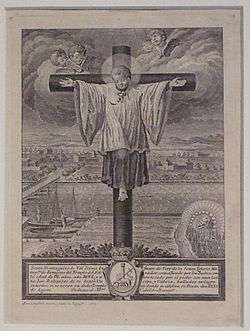Dominguito del Val
| Saint Dominguito del Val | |
|---|---|
|
Dominguito's martyrdom | |
| Martyr | |
| Born |
unknown Zaragoza, Aragon, Spain |
| Died |
c. 1250 Zaragoza, Aragon, Spain |
| Venerated in | Roman Catholic Church, Folk Catholicism |
| Feast | 31 August |
| Patronage | Altar boys, acolytes and choirboys |
Saint Dominguito del Val (died c. 1250) was a legendary child of Medieval Spain, who was allegedly a choirboy ritually murdered by Jews in Zaragoza (Saragossa). Dominguito is the protagonist of the first blood libel (calumnies which spread during the Middle Ages against the Jews) in the history of Spain — stories that grew in prominence in the 12th and 13th centuries of the Middle Ages, and contributed to antisemitic incidents. According to the legend, Dominguito was ritually murdered by Jews of Zaragoza.
Saint Dominguito is no longer included on the official Roman Catholic liturgical calendar; however, there is still a chapel dedicated to him in the cathedral of Zaragoza. There exists little historical evidence of Dominguito aside from the stories and legends built around him.
Dominguito's legend
The historical basis for Dominguito is unclear. No medieval references to the legend have been found; the first texts that recount the tale date from 1583, three hundred thirty-three years after the fact. The drafted appears to have been largely copied from the story of Hugo of Lincoln, collected by Fray Alonso de Espina. According to the accounts, King Alfonso the Wise wrote the original rendition of the story in 1250, saying "We have heard it said that some very cruel Jews, in memory of the Passion of Our Lord on Good Friday, kidnapped a Christian boy and crucified him."
According to the legend, Dominguito was born in Zaragoza and was admitted as a cathedral altar-boy and chorister at La Seo because of beautiful voice. He disappeared on 31 August 1250, when he was seven years old. Some months later, some boatmen discovered the decomposed corpse on the bank of Ebro river.
The bishop of the Cathedral said the boy had been attracted deceived by the Jewish Albayuceto and taken to the mosque premises, where he had been the victim of a ritual murder by Jews, who tried to repeat the Passion of Christ and crucified him on a wall with three nails and opened the side. Then they beheaded him, cut off the feet and buried the corpse on the banks of the Ebro River. All Jews who were imprisoned confessed under torture all that the bishop had said. They were executed in the Plaza de Zaragoza.
The child's bones were later interred in the cathedral, where in the chapel of Santo Dominguito del Val they are still revered as holy relics. However, the cult was suppressed by the Novus Ordo of 1965, along with that of thirty-two others whose historicity cannot be established.
The story is similar to other earlier accounts such as the Holy Child of La Guardia of 1491 and the Santo Niño de Sepulveda. The origin seems to be The Life and Miracles of St. William of Norwich, written by Thomas of Monmouth in 1173. The book tells the story of William of Norwich, an English boy who was found dead near Norwich on Holy Saturday on 25 March 1144, and whose death was attributed to the Jews of the city.
Sources
- Alvarez Chillida, Gonzalo (2002). The Antisemitism in Spain. The image of the Jew (1812-2002). Madrid: Marcial Pons. p. 47. ISBN 978-84-95379-49-8.
- Whitechapel, Simon. Flesh Inferno: Atrocities of Torquemada and the Spanish Inquisition (Creation Books, 2003). ISBN 1-84068-105-5
